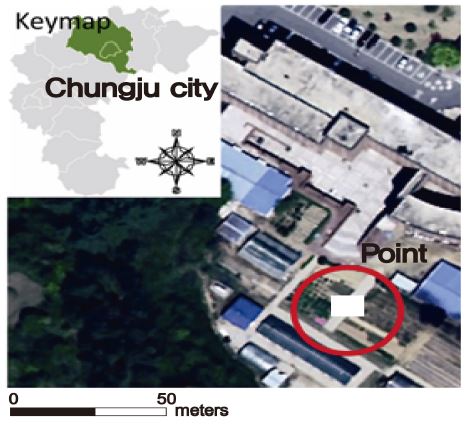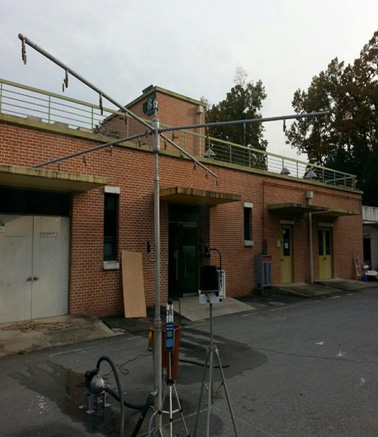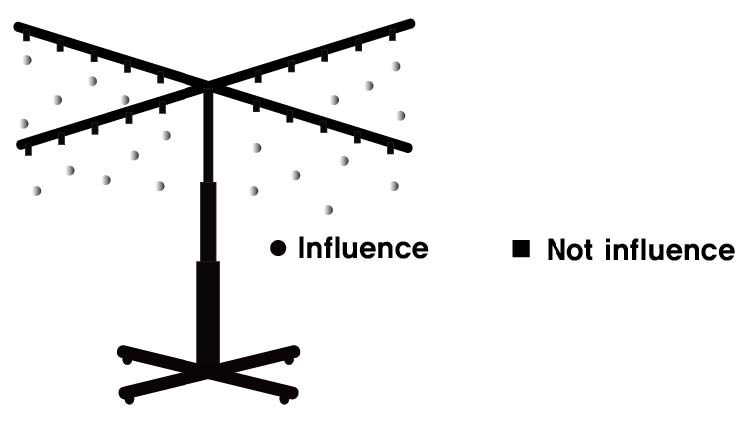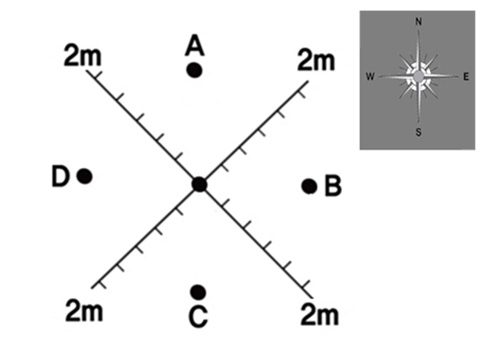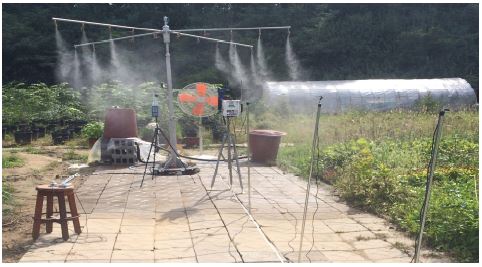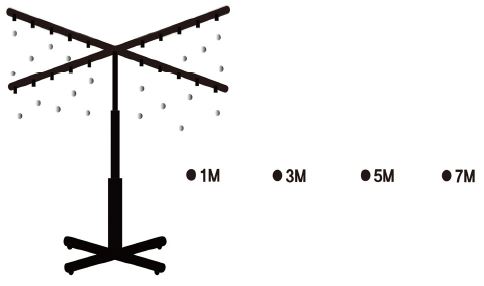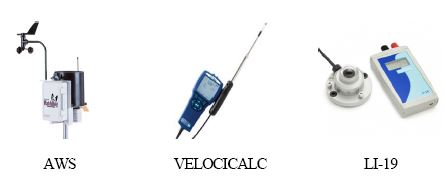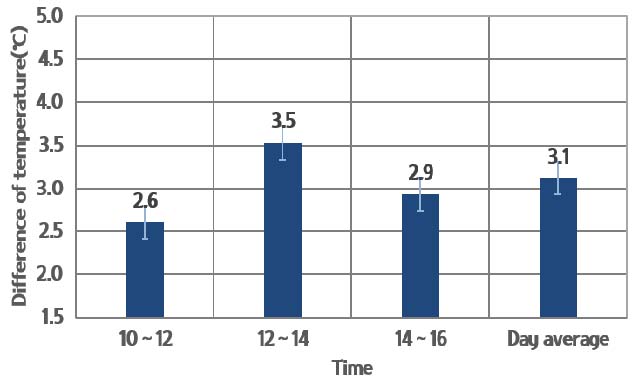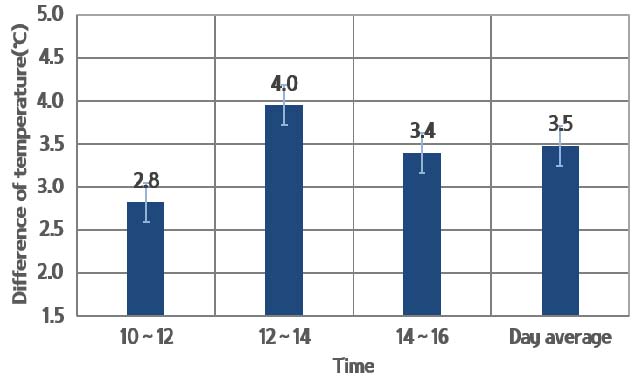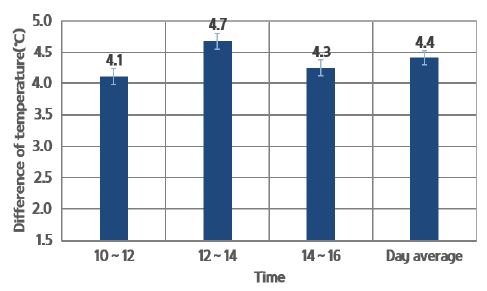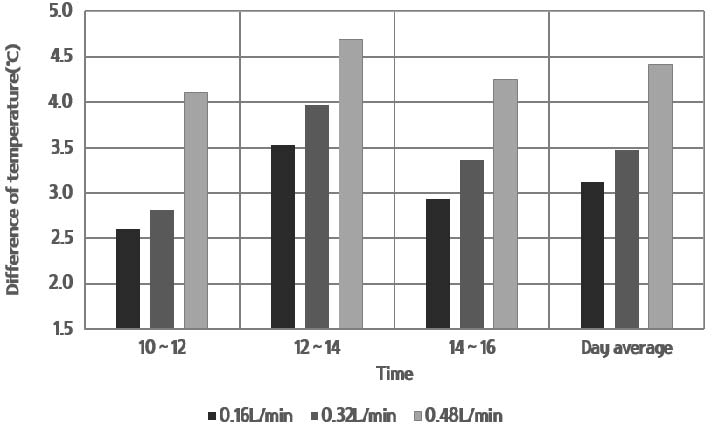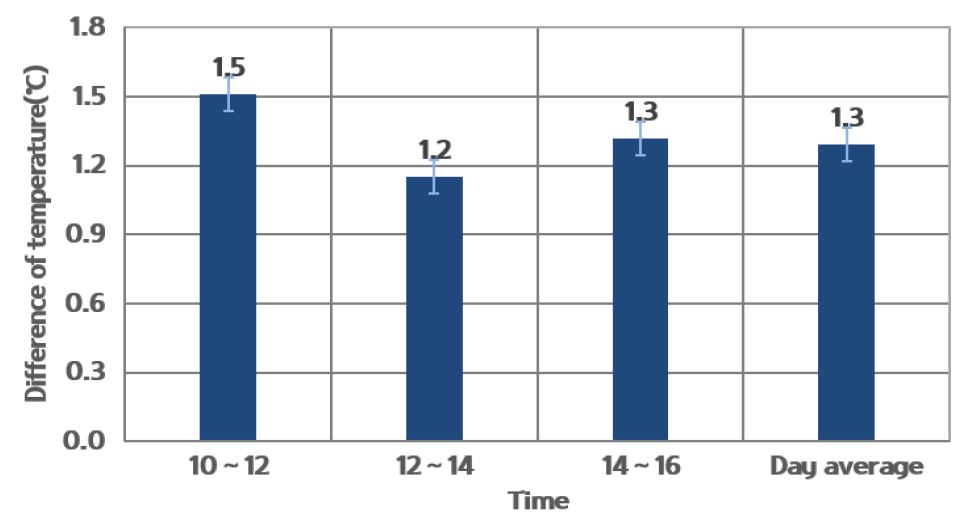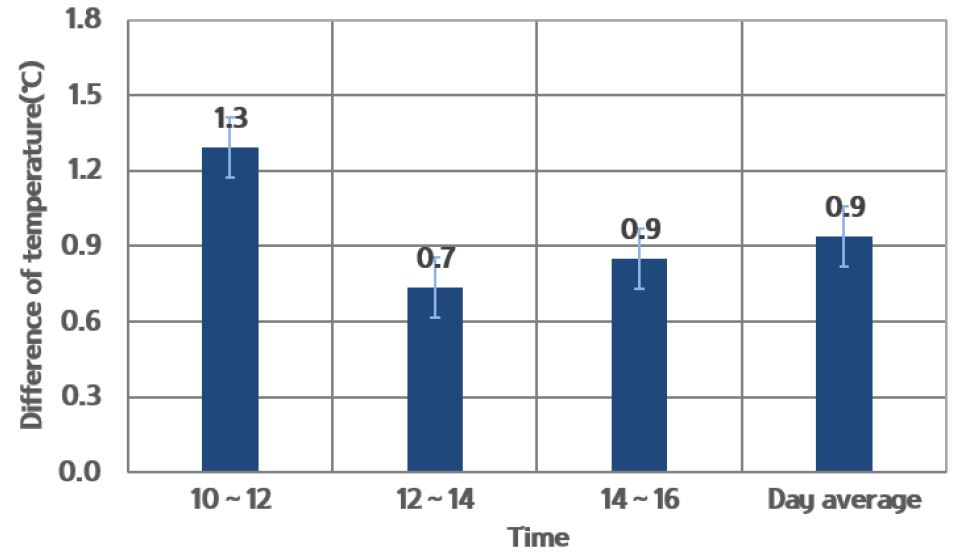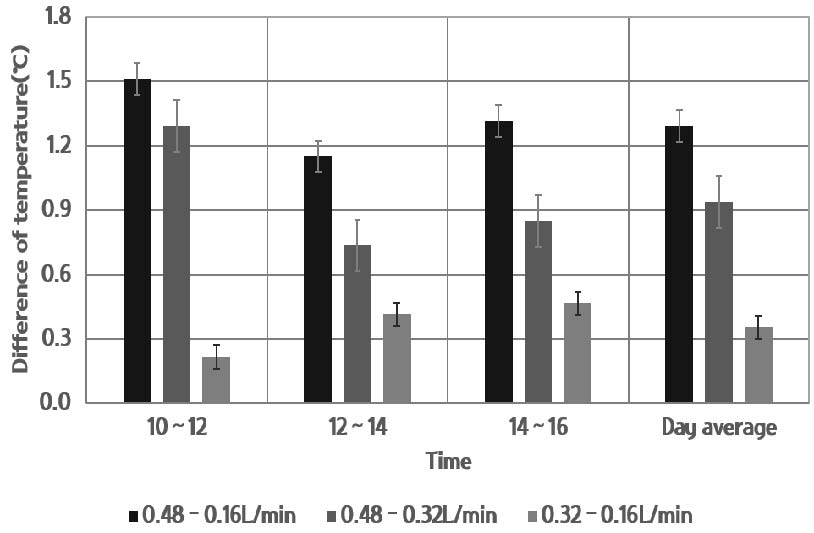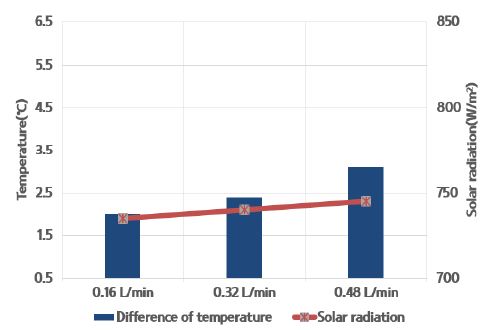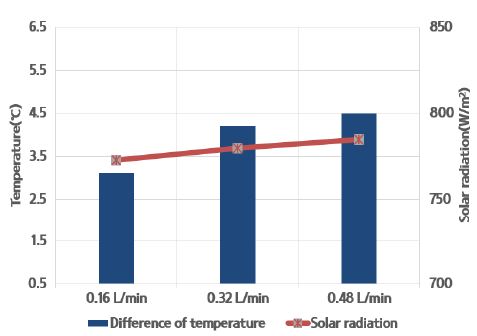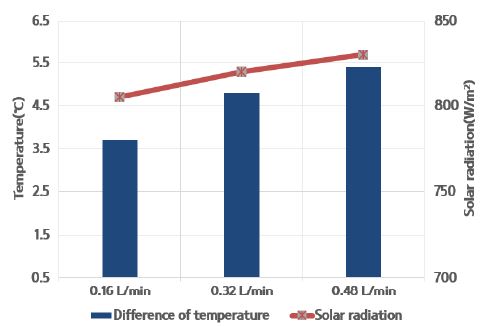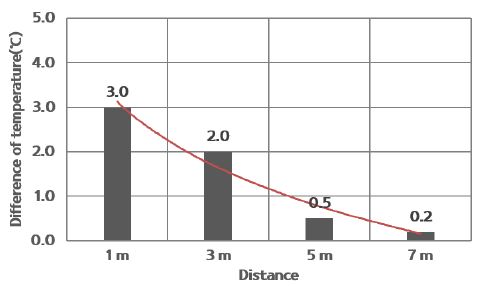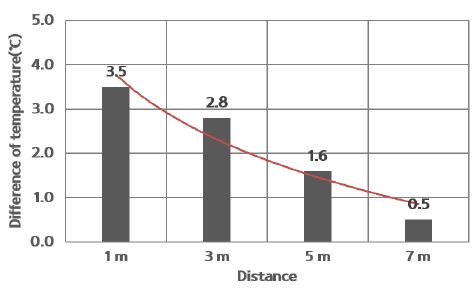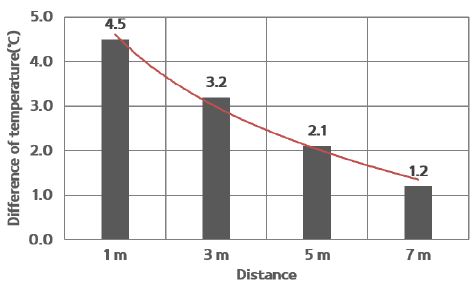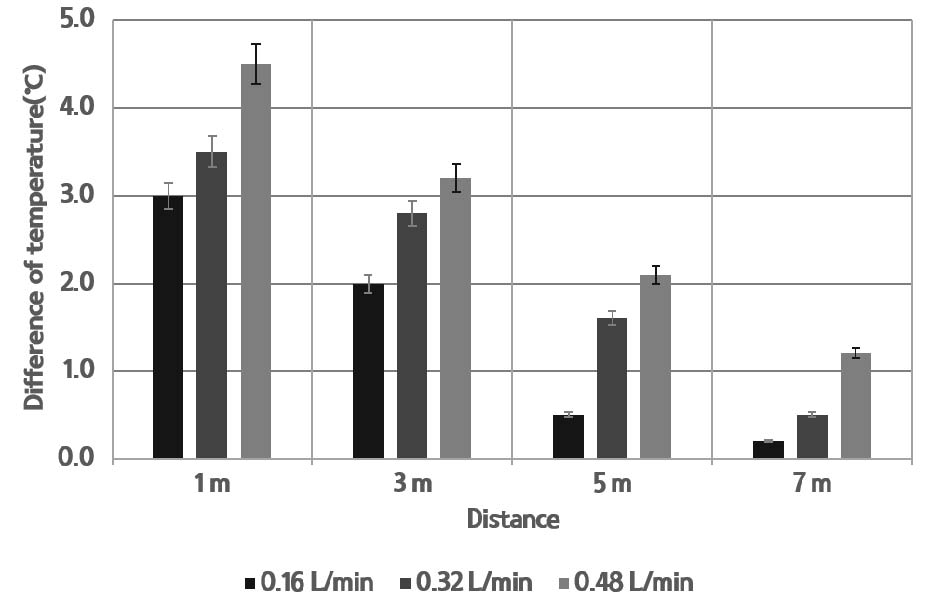
A Verification Study on the Temperature reduction Effect of Water Mist Injection
ⓒ Copyright Korea Institute of Ecological Architecture and Environment
Abstract
Recently, according to climate changes, human health is exposed to danger over the world and they influence all fields of human society. Due to these climate changes, humans can be exposed to more frequent and extreme scorching heat and cold wave than the present. As precautions against these urban higher temperature and dryness, diverse methods are being sought. Among them, as measures to form cold islands, the evaporative cooling effect realistic to social and economic conditions was examined.
This study was conducted to analyze effects of temperature reduction and cooling according to injection quantity of minute water particles by using a blast sprayer as one of alternatives of alleviation of urban climate changes in outside space in summer. For this, through temperature difference in accordance with the injection quantity per hour of a day, a time zone representing the value of the highest temperature change was analyzed.
Also, by analyzing temperature difference according to the injection quantity per daytime insolation, relation of amounts of insolation and evaporation was investigated. Temperature difference in accordance with distances at the highest temperature with the highest value in temperature changes was analyzed.
At the study result, about temperature, as injection quantity increase, temperature reduction was significant statistically at the highest temperature with the most insolation. A factor with the highest influence was judged to be the increase of the injection quantity. According to the injection quantity, it was predicted that 3.1℃ temperature reduction of a daily average in case of 0.16L/min, 3.5℃ temperature reduction of a daily average in case of 0.32L/min, and 4.4℃ temperature reduction of a daily average in case of 0.48L/min.
Keywords:
Evaporative Cooling, Temperature reduction, Water Mist, One-way Analysis of Vaviance1. Introduction
1.1. Research background and objectives
Mild climate due to changes in climate these days frequently generate extreme climate phenomena such as heat wave, intense cold, heavy rain, heavy snow hugely affecting socioeconomic system and natural environment.
Furthermore, urban heat island phenomenon increasing focused on domestic metropolis not only increases building energy consumption but worsens air pollution by increasing ozone concentration in air because of temperature increase. Thus, coping methods towards this currently present the methods that reduce heat absorption amount of building roof and wall (Cool or Green Roofs), methods that reduce heat absorption amount of urban road (Cool or Green Pavements), forest within cities (Shade Tree), creation of green space within cities (Urban Vegetation), formation of water circulation system (Water circulation system).
Summer main issues of human associated with this climate change can be effect and coping of abnormal climate phenomena such as heat wave, typhoon, heavy rain. While possibility of diseases and death by abnormal temperature such as heat wave is increasing, heat wave warnings along with alert were announced nationally in 2013 not to mention the national damage from long-term heat wave due to effect of high pressure in North Pacific near our country. Damage caused by heavy wave varies from affecting personal health to electricity shortage at national level.
Climate change like global warming, urban heat island and heat wave in our country recently causes rapid increase in cooling electricity consumption in summer generating concerns regarding occurrence of national problem in electricity supply with increasing concern towards blackout. As a national response to this, indoor temperature in summer was limited to 28℃ since 2012 and respiratory and skin disease because of too much usage of air conditioner are increasing4). According to the up-to-date data of Korea Energy Management Corporation, rise in cooling temperature in summer has the effect that can reduce the energy by about 7% thus it is expected that 14~21% of energy can be saved upon cooling effect where air temperature decreased by 2~3℃.
Likewise, frequency and intensity of heat wave is worsening and as uncertainty regarding its time of occurrence increases, its damage is getting bigger as well.
Since we can be exposed to more frequent and intense heat wave and intense cold compared to now even in our country, long-term approach towards coping method is required. Besides, as a proper coping methods regarding effect and damage of heat wave, we put importance in temperature reduction using water mist.
Evaporative cooling effect not only reduces building energy but copes with heat wave and urban heat island and is a part of cooling method that uses principles to lower surrounding temperature absorbing nearby heat energy through fast evaporation of water mist sprayed after spraying small sized water droplets to hot air. Yoon et. al.1) proposed that installation of evaporation cooling effect system can have cooling effect by as a result of performance evaluation by field experiment utilizing cooling system. In addition, cooling system using water droplets is reported to provide pleasantness obtained from cooling to users2), as well as proposing proper control method to facilitate the usage of Water Mist Cooling System using water droplet3).
Gibe-Hong4) as well evaluated that evaporation cooling effect using water droplet is effective when installed in half-open space with outer roof and reported that it was applied to urban railway station, driving range, exhibition in Japan while in Korea it was installed in amusement park, Daejeon ocean world, Yeosu EXPO, chungju world rowing championship 2013 recently. This Water Mist Cooling System can obtain cooling effect by being installed temporarily in benches for example which are exposed to sunlight during daytime and it is also possible to obatin various visual effect with lights at night. Currently, this cooling system is now widely used in the country but it is considered as the most effective and best water and temperature control system using water.
Likewise, there is a need for installment of eco-friendly water droplet mist with energy reduction and temperature reduction effect at outside in summer but domestic researches on system application and creation of water space in the aspect of evaporation cooling effect are still deficient.
According to this, this research intended to examine temperature reduction effect by amount of water mist using mist spray, one of alternative of heat island because of betterment in urban city climate then utilize it as basic data in coping with heat wave.
1.2. Research scope
This research intended to spray water mist outside and examine its cooling effect and directly customized water mist to analyze the effect of mist amount and cooling effect by exposure and composition of experimental device used in this research.
Research target location was laboratory of green fusion technology department of Kunkuk university located in Chunju, Chungbuk like Fig. 1 and research was done for approximately 5 months, from June to November of 2014. Experimental device was installed in asphalt which is impermeable wrapping and nearby soil was mostly shielded with artificial features. July to June became the target of focused investigation because it has rather high monthly average temperature in analyzing weather factors that affect the temperature reduction the most with prominent features of heat island phenomenon due to highest average temperature and insolation among 5-month period.
2. Pilot study contemplation
According to Giduk, Kim and others6) if we use evaporative latent heat which is the effect of mist water spray on microclimate, air temperature can be cooled effectively. EXPO2005 exhibition in Japan directly propose this active utilization and reported that applying that cooling effect to specific urban space is equal to lowering 2℃ of air at 7m height per minute as an evaporation effect generated in green space with 100m×100m size.
When applying micro water spray indoor, Sa-Keun, Park and Hun, Shin5) used humidifier used for indoor humidity in winter instead of using nozzle indoor to examine possibility of cooling effect. To add, through measurement result according to the degree of humidification (13㎖/min, 10㎖/min, 7.5㎖/min) and the presence of atmosphere generation (distance 1.5 ~ 1.8m/s), cooling effect by evaporation can be subtle by water sprayer causing increase in relative humidity in closed space like indoor but depending on the degree of humidification, temperature reduction effect by 1∼1.5℃ was observed. But it was reported that there is a need for review in that indoor cooling effect should be considered comprehensively along with temperature and humidity, air current speed, radiation temperature. Besides, to examine the cooling effect of water spray quantitatively, we performed an experiment at indoor and outdoor and as a result, we confirmed sensory temperature reduction effect by 4.0~6.0℃ at maximum outside and by 1.0~1.5℃ inside.
On the other side, Gibe-Hong4) performed basic experiment regarding cooling temperature measurement by one nozzle, changes in water mist droplet and spray pressure through experiment using water mist of one nozzle and as a result, he proved that the droplet size of water mist decreases as spray pressure increases showing that big droplet is 40% when spray pressure is 4㎫ and droplet smaller than 19㎛ is 40% when spray pressure is 9.5㎫.
Many data that evaporation cooling effect from water droplet sprayer affects temperature reduction in indoor space isolated from outdoor have been proved. On the other hand, no one paid attention to the aspect of methodology that mentions the cooling effect of air by climate change specifically and prevents this as a way in heat island aspect and researches on fine dust reduction effect in cities or localized cooling effect through water droplet sprayer are almost not being done.
Thus, this research installed water droplet sprayer in outdoor space of building in summer then comprehended the experiment quantitatively regarding temperature reduction effect of water droplet mist amount investigation its function on evaporation cooling effect.
3. Research method
3.1. Installment of water mist
Experimental equipment was installed on asphalt, impermeable wrapping, like Fig. 2 and inverter was used to control the flow along with 5㍱ pump. Water mist supplies highly pressured water (50~60bar) being the device possessing flow of 0.04L/min per nozzle and is a system that controls pleasant environment by spraying fine water through optimal design to expect the range of cooling effect. By spraying water particle smaller than 100㎛, evaporation cooling was designed to be enabled right after spraying without getting wet.
Nozzle was installed at 3m height then valve was installed to change the amount of mist according to need for experiment. 4 pipes with 5 nozzles by direction were allocated in a cross shape and each nozzle was installed in spraying form. Like in Fig. 2, 3, this research customized water mist for experiment. The most
effective utilization of water mist is evaporation cooling right before contact of water with the ground and it is important to control the intensity in pressure and spray nozzle to make the water particle finer.
3.2. Measuring method
In case of LI-19 solarimeter used as auxillary equipment of climate factors, tis class is second class certified by ISO with wavelength range 0~1,600Wm-2 or 2,000 Wm-2 and usage temperature range within –40~80℃. To analyze insolation of measured date, we selected location not affected by water particles and measured insolation.
Water mist was operated from 10:00 to 16:00 and in case of indoor temperature management by time was done by direction of water mist installed. Additionally, to minimize error range, we divided it into 4 spots like Fig. 4 and measured, generalized it at A, B, C, D point every one minute through automatic weather research craft. A point was North (N), B point was East (E), C point was South (S), D point was West (W).
Like Fig. 3, outer temperature was measured at the same time after installing cradle at point from 10m not affected by water mist. By putting difference in amount of mist upon measurement, 0.16L/min, 0.32L/min, 0.48L/ min were sprayed and temperature change was examined analyzing the difference value in each measured temperature after spraying.
Like shown in Fig. 2, 3, 5 nozzles are attached to each pipe and mist amount was controlled with each 1, 2, 3 nozzle in four pipes then measurement by mist amount was compared, analyzed clarifying temperature reduction difference by 1 nozzle, 2 nozzles, 3 nozzles. Mist amount by one nozzle was 0.04L/min and each mist amount was measured to be 0.16L/min(4ea × 0.04L/min), 0.32L/min(8ea × 0.04L/min), 0.48L/min(12ea × 0.04L/min).
Measurement time of insolation, indoor and outdoor temperature was from 10am to 4pm and it was done to analyze temperature difference by mist amount by insolation.
Indicating the point 1m from the center of the mist as indoor like Fig. 5, 6 below, three points 3m. 5m. 7m away from the center were selected. It was measured when insolation was the highest with the highest temperature before and after 14:00 to analyze the realtion between evaporation time and temperature change. Besides, with difference in mist amount, each difference by distance and temperature change upon spraying 0.16L/min, 0.32L/min, 0.48L/min were analyzed.
3.3. Measuring device
Fig. 7 used Watch dog 2000 Series(AWS : Automatic Weather System, Spectrum Technologis Inc.), an automatic weather research craft, to measure climate factors with the measuring device list. Climate factors are insolation, temperature, wind direction, wind velocity, relative humidity and temperature reduction effect of water mist was analyzed through this. Measurement time had interval by 1 minute showing average value and measured difference in climate factors inside and outside water mist and evaporation cooling effect by distance.
Solarimeter (VELOCICALC) can measure the temperature and wind velocity at the same time and this was used to analyze the effect of evaporation cooling and temperature reduction effect of water mist by wind velocity.
Also, solarimeter (L1-19) was used to analyze and compare the difference indoor and outdoor temperature and evaporation cooling effect of water mist by solar radiation.
3.4. Statistical analysis
This research used SPSS Statistics 18 program to clearly analyze the value of temperature difference by water mist and confirm significance between measured data and performed Duncan multiple range test at 5% level and one-way ANOVA. To analyze the temperature difference indoor and outdoor by water mist, we chose the method of one-way ANOVA which analyzes difference in temperature reduction by each mist amount setting outer temperature of target as one independent variable.
4. Result and analysis
4.1. Outdoor insolation measurement
Selecting 7 days with the highest average air temperature as a result of measuring insolation in summer, measuring time of this research, it was shown in time graph and the insolation of this average value showed the highest tendency before and after 13-14:00, which shows the highest temperature. This showed similar result to the distribution of summer air temperature generating heat island phenomenon because of artificial features in cities.
4.2. Temperature difference at indoor and outdoor by mist amount by daily time
(1) 0.16L/min
Following graph in Fig. 8 shows the value of temperature value of mist amount of 0.16L/min by daily time. As a result of temperature difference analysis by measuring types, 10-12:00 showed average temperature difference by 2.6℃ and 12~14:00 showed average by 3.5℃, while 14~16 showing average by 2.9℃ with daily average temperature difference 3.1℃. The time range with the highest value of temperature difference was 12-14, and it was judged that highest temperature before and after 14 showed the highest temperature change value.
(2) 0.32L/min
As a result of temperature change value of mist amount 0.32L/min, following graph in Fig. 9 shows the result. As a result of temperature difference result by measuring time, 10-12 showed 2.8℃ temperature difference on average while12~14 showed 4.0℃ on average, 14~16 showed 3.4℃ on average with 3.5℃ in daily average temperature difference.
(3) 0.48L/min
Following graph in Fig. 10 shows the temperature change value of mist amount 0.48L/min by daily time. As a result of measuring temperature difference by time, 10-12 showed 4.1℃ temperature difference on average, 12~14 showed 4.7℃ on average, 14~16 showed 4.3℃ on average with analyzed data of 4.4℃ on daily average. The time with the highest temperature difference value on average was 12-14, showing the highest temperature change value at maximum temperature on daily average as shown in above two types. Like pilot research of Lee, Hyun-woo and Kim, Young-sik,9) it was determined that enough cooling effect can be obtained through adjustment such as increasing mist exposure time or the number of nozzles since increase in mist amount can heighten evaporation cooling effect much more.
(4) Comparison analysis
Following graph in Fig. 11 shows analysis that combined temperature difference in three types. As a result of analysis, temperature difference showed a tendency to increase as mist amount increases. That difference showed temperature reduction by about 4.0~5.0℃ at maximum and as a result of performing water mist outside, it had temperature reduction effect by 4.0~6.0℃ at maximum. Outside temperature rapidly decreases as water is sprayed and when water mist stops to operate, the temperature starts to reverse rising up to the temperature near water mist operation as time lapses. This was the similar tendency to pilot research5)8) and we could confirm that temperature difference distribution by water mist by time lapsed was uniform.
As what we examined in distribution change in temperature difference by time lapsed, distribution change of temperature difference was shown somehow large as mist amount increases during the day9). Although deviation occurrence of temperature difference by water mist is not large. it is considered to be because of deviation generated by climate factors such as momentous solar radiation blockage by cloud movement and temporary wind velocity of the wind.
Besides, the highest temperature difference by daily time was measured to be 12-14 and this was determined to be shown before and after 14, the highest temperature as a result of insolation.
(1) 0.48L/min-0.16L/min
Graph in Fig. 12 shows difference value in temperature difference of two types. Thus it is the result that temperature difference value 0.16L/min was deducted from 0.48L/min temperature difference value. As a result of temperature difference value analysis by time 10~12 showed 1.5℃ difference, 12~14 showed 1.2℃, 14~16 showed 1.3℃ with daily average temperature difference value being 1.3℃.
(2) 0.48L/min-0.32L/min
Graph in Fig. 13 is the result where temperature difference 0.32L/min was deducted from 0.48L/min temperature difference. As a result of value analysis in temperature difference by time 10~12 showed 1.3℃ difference, 12~14 showed 0.7℃, 14~16 showed 0.9℃ with daily average temperature difference value being 0.9℃.
(3) 0.32L/min-0.16L/min
Graph in Fig. 14 as well shows difference value in temperature difference. This is the result where 0.16L/min temperature difference value is deducted from 0.32L/min temperature difference value. As a result of temperature difference value analysis by time 10~12 showed 0.2℃ difference, 12~14 showed 0.4℃, 14~16 showed 0.5℃ with daily average temperature difference value being 0.4℃.
(4) Comparison analysis
Graph in Fig. 15 combined and analyzed the value of temperature difference of three types. As a result of analysis difference value of 0.48L/min-0.16L/min showed the highest temperature difference value and difference value of 0.32L/min-0.16L/min showed daily average 0.4℃ with subtle temperature difference. This is seen to be temperature change according to the difference in water mist amount.
Besides, it was analyzed to maintain a stable temperature difference value during spraying time from 10 to 16 after air temperature decreased by 2~4℃ approximately since the temperature decreased rapidly together with water mist.
4.3. Temperature difference by mist amount by insolation
To analyze the temperature difference by mist amount by insolation, we intended to measure insolation by time after setting measuring time in a day as 10-16 and analyze the effect of the change on temperature difference. Graph in Fig. 16 shows temperature difference of 700~750W/m2 insolation. 0.16L/min showed average temperature difference by 2.0℃, 0.32L/min showed average 2.4℃, 0.48L/min showed 3.1℃ temperature difference on average. This is shown to increase with the effect of mist amount when insolation possesses a certain value.
Graph in Fig. 17 shows temperature difference of 750~800W/m2. 0.16L/min showed 3.1℃ temperature difference on average, 0.32L/min showed average 4.2℃, 0.48L/min showed 4.5℃. Besides temperature difference value rather increased compared to insolation 700~750W/m2 and this was considered to be the effect due to insolation increase.
Fig. 18 shows temperature difference of insolation 800~850W/m2. 0.16L/min showed average temperature difference by 3.7℃, 0.32L/min showed 4.8℃ on average, 0.48L/min showed 5.4℃. Besides upon maximum temperature of the day with the highest insolation temperature difference showed maximum value and this was considered to show temperature change value increasing evaporation amount as mist amount increases.
When examining insolation during mist hour, we could see that solar shading ratio was relatively low by water droplet. Combining these implies that temperature drop period gets longer as water mist amount increases but proper control on water droplet mist time is needed since humidity disorder is expected through continuous maintenance of increased humidity. This showed the similar trend to the researches presented in the review of cooling effect from mist time10).
4.4. Temperature difference by distance at maximum temperature
To analyze temperature difference by distance at daily maximum temperature on average, 1m, 3m, 5m, 7m distance was set in a straight line from the point where water mist is installed then temperature difference was analyzed. Besides mist amount was differentiated to 0.16L/min, 0.32L/min, 0.48L/min to help each measurement.
Fig. 19 showed temperature reduction effect more than 1℃ until 3m straight line in case of 0.16L/min, temperature difference was shown 1m > 3m > 5m > 7m in order. From 5m point, temperature difference was shown to be subtle because of water droplet evaporation.
Like Fig. 20, 0.32L/min showed temperature reduction effect more than 1℃ until 5m straight line, temperature difference was measured to be 1m > 3m > 5m > 7m in order. As well, 7m point showed subtle temperature difference due to evaporation of water droplet.
Graph in Fig. 21 very different from above two measurements show temperature reduction effect more than 1℃ up to 7m in a straight line in case of 0.48L/min, temperature difference was shown to be 1m > 3m > 5m > 7m in order. Besides, temperature difference by distance at maximum temperature was analyzed to affect depending on the mist amount.
As a result of measuring temperature change with difference in mist amount, it was analyzed that temperature reduction width decreases as distance from the mist spray decreases regarding evaporation cooling effect of water droplet by distance and as mist amount increases, influencing range of temperature reduction tended to increase as mist amount increases. Mist amount by distance was considered to affect temperature difference.
4.5. Result of variance analysis of temperature difference by mist amount
Considering outer temperature difference by mist amount as independent variables, one-way ANOVA was performed setting inner temperature and temperature difference by mist amount as wind variables. Analysis result is like Table 1.
Outer temperature field exceeds significance level of 5%, F-ratio value is 1.148 helping us judge that difference in outer temperature does not affect temperature difference by mist amount. But as mist amount increases, internal temperature and its difference all satisfies significance level 5% exceeding F-ratio value 2.99 so it can be said that there is a difference in temperature reduction by mist amount of each group.
Table 2 shows the result of multiple range test of result of inner temperature reduction by mist amount difference. According to statistical analysis, temperature difference was analyzed to be high in order of Type S3 > Type S2 > Type S1. To add, mist amount of all three Types showed significance.
5. Conclusion
This research is based on summer when solar altitude is the highest and was done for 5 months since June to October of 2014 when heat island phenomena is prominent with the highest yearly average temperature and insolation.
Water mist sprayed through each nozzle and temperature reduction effect by distance at maximum temperature, insolation, daily time by mist amount was examined. Thus, through application of water droplet mist at outside we obtained the following conclusion as a result of performance analysis of temperature reduction.
- (1) Temperature difference by mist amount by time was 1.0℃, 3.5℃, 4.4℃ spraying 0.16L/min, 0.32L/min, 0.48L/min as a result of measuring from 10:00 to 16:00, 12-14 showed the highest temperature difference.
- (2) Temperature difference by mist amount by insolation was analyzed to be in order of 700~750W/m2, 750~800W/m2, 800~850W/m2 and the width of temperature difference tended to increase as insolation increases.
- (3) Temperature difference by distance at maximum temperature induced the trend of temperature difference increase width by putting difference in mist amount and although there is a difference in mist amount the temperature difference value showed the trend of decrease as distance increases. Additionally, 0.16L/min mist showed the effect up to 3m, 0.32L/min to 5m, 48L/min to 7m.
In conclusion we intended to research about the scope of temperature reduction effect by selecting target locations composed of impermeable wrappings and building in its soil shielding condition in outer summer space through water mist sprayer, coping methods towards urban heat island phenomenon due to climate change.
As a result, when supply of fine water droplet is actively introduced to hot, dry area, change width in temperature difference and temperature reduction effect by mist amount by water mist were analyzed to be caused by lowered temperature rise due to evaporation cooling. There will be a need for verification method for water mist that widely applies, circulates a certain area to pleasant environment such as heat pleasantness analysis and fine dust reduction by particle size, mist amount utilizing fine water particle in metropolis where there are many impermeable wrappings in thermal environmental aspect afterwards.
Acknowledgments
“This research was supported by Basic Science Research Program through the National Research Foundation of Korea(NRF) funded by the Ministry of Education(NRF-2015R1A1A2058239)”
References
- G. Yoon, et al. , “Study on cooling system by using dry mist-validation of cooling effectiveness and CFD simulation”, Environ Eng, (2008), 73(633), p13-20.
- G. Yoon, and M. Okumiya, “Cool spot in urban area Dry Mist system-”, Proceeding of The Society of Heating, Air-Conditioning and Sanitary Enginners of Japan, (2009), 83(8), p651-657.
- Gyuyoung Yoon, Hideki Yamada, nad Masaya Okumiya, Study on cooling system with Using Water Mist control Stratagy for Water Mist system Renew able Energy, (2010), 22, p25-29.
-
홍기배, “Water Mist를 이용한 Cooling System의 특성에 관한 연구: 한 개의 노즐에 대한 실험을 중심으로”, 한국교통대학교 2013 논문집, 48, p27-32.
Hong, Ki-Bea, A Study on the characteristics of cooling system using water Mist, Korea National University of Transportation Journal, (2013), 48, p27-32. -
박사근, 신훈, 송민정, 장길수, “미세물분무의 냉각효과에 관한 실험적 연구”, 대한건축학회 2005 학술발표대회 논문집, 25(1), p223-226.
Park, Sa-Keun, Shin, Hoon, An Experimental Study on Cooling Effect of Water Mist Spray, Journal of Architectural Institute of Korea, (2005), 25(1), p223-226. -
김기덕, 이응호, 김원배, 이준구, “곤달비 여름재배시 냉각방법과 냉수호스 베드재배가 생육 및 미기상에 미치는 영향”, 한국생물환경조절학회 학술발표 논문집, (2011), 20(2), p116-122.
Lee, Eung-Ho, Kim, Won-Bae, Lee, Jun-Gu, Effects of Several Cooling Methods and Cool Water Hose Bed Culture on Growth And Microclimate in Summer Season Cultivation of Narrowhead Goldenray, Journal of Bio-Environment Control, (2011), 20(2), p116-122. -
김영찬, “초음파진동을 이용한 미세분무냉각 열전달에 관한 실험적 연구”, 한국액체미립화학학회지, (2010), 15(4), p202-207.
Kim, Yeung-Chan, The Experimental Study on Mist Cooling Heat Transfer, Journal of Ilass Korea, (2010), 15(4), p202-207. -
강정윤, 최동호, 임홍성, 허종철, “미스트 분무 및 스프링클러 관수가 단동 플라스틱 하우스에 미치는 냉각효과”, 제주대학교 산업기술연구소 학술저널, (2000), 11(2), p1-12.
Kang, Jeong-Yun, Choi, Dong-Ho, Im, Hong-Sung, Huh, Jong-Chul, A Study on Cooling Effects of Spray Mist or Sprinkler on Single Span Plastic Greenhouses, Journal of Research Institute Of Advanced Technology, (2000), 11(2), p1-12. -
이현우, 김영식, “상업용 토마토온실 냉방을 위한 저압분무식 포그시스템의 적용”, 한국생물환경조절학회 학술발표 논문집, (2011), 20(1), p1-7.
Lee, Hyun-Woo, Kim, Young-Shik, Application of Low Pressure Fogging System for Commercial Tomato Greenhouse Cooling, Journal of Protected Horticulture and Plant Factory, (2011), 20(1), p1-7. -
허종철, 최동호, 임종환, 서효덕, “미스트 분무시간 및 휴지시간 변화에 따른 하우스 냉각효과 검토”, 한국생물환경조절학회 학술발표 논문집, (1999), 8(2), p59-62.
Huh, Jong-Chul, Choi, Dong-Ho, Im, Jong-Hyan, Suh, Hyu-Duk, Evaluation of Cooling Effects in Greenhouses with Mist System at Variations of Spraying or Non-spraying Time Durations, Journal of Protected Horticulture and Plant Factory, (1999), 8(2), p59-62. -
주창훈, 김정호, 윤용한, “도시 열환경을 고려한 녹지관리방안 수립 연구”, 한국환경과학회지, (2014), 23(7), p1349-1358.
Joo, Chang-Hun, Kim, Jeong-Ho, Yoon, Yong-Han, A Study on Green Space Management Planning Considering Urban Thermal Environment, Journal of Environmental Science International, (2014), 23(7), p1349-1358. [https://doi.org/10.5322/JESI.2014.23.7.1349]
